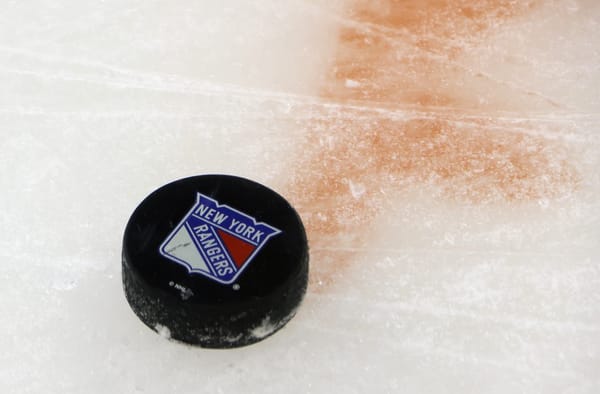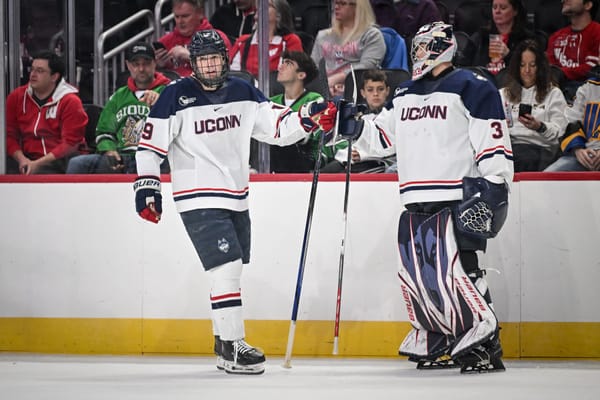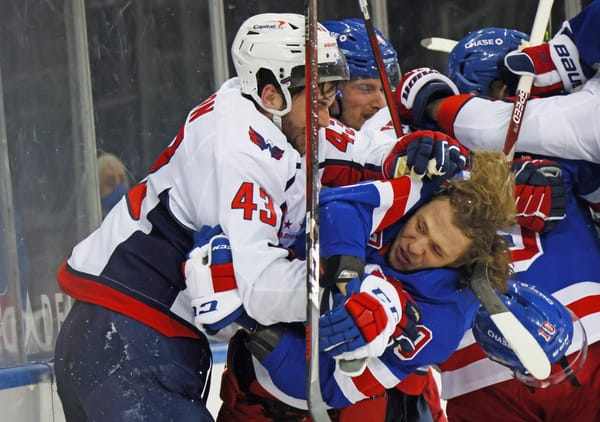NHL Releases Document Detailing Phase 2 of Return-to-Play Plan
The 21 page document covers a lot of information
The NHL and NHLPA recently agreed to the structure of a 24-team playoff format, and on Monday the league released a lengthy document with a variety of information. I’d recommend checking the whole thing out when you have the chance, but here are a few highlights to help you get up to speed.
The league is looking to introduce the second phase in the beginning of June, although at this point there is no definitive timeline. This phase includes primarily small group workouts in which no more than six players at a time can voluntarily return to NHL facilities.
Types of activities permitted, listed under H. on page 6 & 7, are as follows per Sportsnet:
Players may participate in player-only, non-contact skating sessions (without coaches), weight training (no spotters required), cardiovascular training, and circuit-based training. Rehabilitation and treatment with medical and training staff is also permitted. Once separated into groups, players will remain in those same groups for all training sessions for the duration of Phase 2. Groups will be scheduled into “shifts” and will not overlap in timing so as to allow for proper cleaning of facilities between each group’s training session. On-ice time must be divided equally between all skaters in small groups of no more than six players, though goaltenders may be allowed additional ice time. Goalies are permitted to work with an independent goalie coach on a one-on-one basis, beginning seven days after initially being granted access to club facilities.
Of note: Players and team staff will be given a COVID-19 nasal swab test two days before starting Phase 2 training, and then will be tested at least twice per week afterwards. They must also self-administer a temperature and symptom check every day.
— Chris Johnston (@reporterchris) May 25, 2020
This setup means that no players will be forced to return to their home city if they have since returned to their offseason home, but those who do decide to comeback will have to follow certain guidelines.
For example on Page 2 of the released document:
Prior to resumption of small group activities, some individuals (Players and “Permitted Personnel” –see I (1-3))traveling back to their Club’s home city may be required to serve a 14-day self-quarantine imposed by the local health authorities, regardless of their mode of travel (private or charter travel). Even if not imposed by the local health authorities, such individuals returning to the Club’s home city by public transportation,including commercial air or rail travel,must serve a 14-day self-quarantine period post-travel before engaging in training activities at their Club’s facility.
In addition, Club Medical personnel may impose a 14-day quarantine on Players and Permitted Personnel returning to the Club’s home city from a high-risk environment, even if they are not travelling via public transportation. Guidelines for the designation of high-risk environments will be provided to Clubs by the NHL in consultation with the NHLPA as soon as practicable.
However, Clubs are not permitted to require that Players who are currently sheltering in place outside of the Club’s home city return to the Club’s home city so that they can complete a quarantine in time to participate in Phase 2. Players shall avoid carpooling together from one location to the Club’s home city. To the extent such carpooling occurs, post-travel quarantine for individuals involved shall be considered at the Club’s discretion.
For a team like the Rangers, who have a number of players currently outside of North America, there could be an extra two week wait for such players looking to participate in these voluntary sessions. Those who remained local could also be subject to this 14-day quarantine, as New York has been a COVID-19 hot spot, but that is something that remains to be seen.
The other big elements covered in the document refer to symptom checks, testing, and what happens if a player tests positive for COVID-19. These are outlined on page 2, 3, and 4 under headers C and D, and under G which is on pages 5 and 6. I would recommend reading these sections in full, but here’s the basics explained.
During Phase 2, all players and personnel allowed to return to training facilities will be tested 48 hours before entering, and will undergo testing twice weekly. These results are expected to be available within 24 hours, and the individual will only be allowed entrance if their test comes back negative.
Laboratory-based RT-PCR testing shall be administered to all Players and Club personnel designated to have “Player Access” (see Paragraph I (2) below) forty-eight (48) hours prior to any person returning to Club training facilities in order to detect active or recent infection (with results to be available within twenty-four (24) hours). For individuals whose results are not received within twenty-four (24) hours, such persons shall not utilize Club training facilities until results are available and indicate a negative testing result.
Additionally, players will need to monitor themselves and complete a self-screening checklist at home, and once again before returning to the facility. Along with this, if a player develops any symptoms, they must inform their team and isolate themselves until they can be evaluated.
In the event a Player is diagnosed positive for COVID-19 (or has a resulting and/or related illness), the Club Physician shall issue an Exhibit 25-A designating the Player as “unfit to play”, the Player shall be deemed to have sustained an illness arising out of the course of his employment as a hockey player for such period as he may be removed from training, practice or play, and his condition shall be treated as a hockey related injury for all purposes under the Collective Bargaining Agreement, unless it is established, based on the facts at issue, that the Player contracted COVID19 or the resulting or related illness outside the course of his employment as a hockey player.
All Players and Club personnel shall immediately notify Club medical staff if he or she suspects coming into contact with someone that has COVID-19. The following are common symptoms of COVID-19:
• Cough
• Shortness of breath
• Chest pain
• Feeling feverish, chills
• Muscle pain (not exercise-related)
• New loss of smell or taste
• Gastrointestinal symptoms (nausea, vomiting and/or diarrhea)
• Sinus or cold-like symptoms (headache, congestion/runny nose, sore throat).
• Fever (temperature > 99.5°F or > 37.5°C)
Club medical staff, in consultation with the Club’s infectious disease specialist, shall direct the care of anyone who tests positive.
For reference, a link to CDC guidance on discontinuation of isolation following positive COVID-19 in symptomatic and asymptomatic patients is provided. (https://www.cdc.gov/coronavirus/2019-ncov/hcp/disposition-in-home-patients.html) Players, however, shall remain entitled to consult with their personal physicians during their participation in Phase 2.
This should be pretty straightforward stuff, but it still is good to have it outlined in full so the players can monitor themselves accurately.
In summary, the document outlines the steps the league will look to take soon. They want to give players the opportunity to start getting back into game shape, but they want it to be done safely. While this is good in theory, it comes down to how teams and players follow the guidelines, and what will happen if there are a number of positive tests stemming from this return to training.
Ultimately, I think there is some reason to be skeptical of this plan given some of the parameters hinge on players accurately monitoring symptoms and speaking to their health, because we have seen numerous cases in the past of players gritting through concussions and other injuries. It is also my hope that this process doesn’t take away supplies and tests that could be otherwise utilized by those currently working on the front lines.
Like anything else, we will have to see how things pan out once there is a date in place, and hopefully those who participate in these early sessions can do so safely.
Thoughts?





